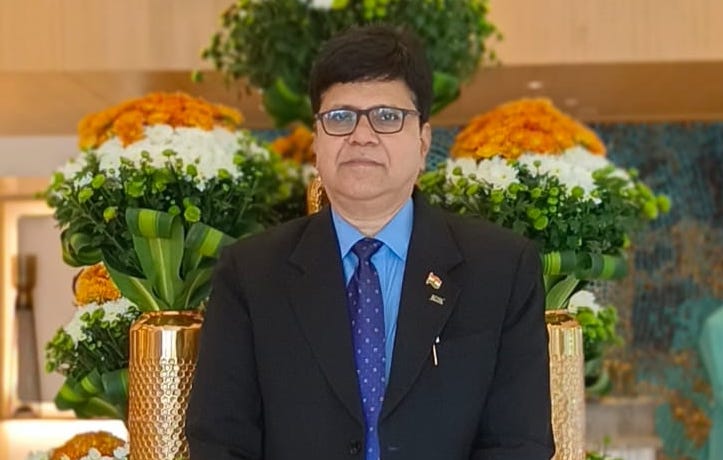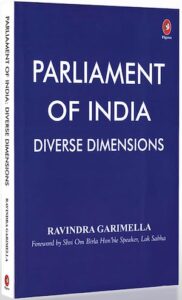Inside the Indian Parliament: Insights from veteran parliamentary officer Ravindra Garimella

Ravindra Garimella
Author of “Parliament of India: Diverse Dimensions” discusses the intricacies of parliamentary procedures, his extensive career, and the evolution of India’s legislative system
Ravindra Garimella, a seasoned parliamentary officer with over 30 years of experience in India’s Lok Sabha Secretariat, offers a comprehensive look into the intricate workings of the Indian Parliament in his book, “Parliament of India: Diverse Dimensions.” Published by Pigeon Books India, the book delves into key aspects of parliamentary procedures, including the concepts of “Zero Hour” and “Working Hours” in Parliament. Garimella’s rich experience shines through as he draws upon wisdom from several eminent Indian political personalities, making the book a valuable resource for anyone interested in the legislative process. Released earlier this year, the book is available on Amazon.
Garimella’s distinguished career in Parliament includes serving as Joint Secretary (Legislation), overseeing legislative business such as Government Bills, budgetary processes, and parliamentary privileges. He has held a variety of critical roles, from Officer at the Table for 25 years to Assistant Returning Officer for the 2017 Presidential Elections. His extensive work also spans parliamentary committees such as the Committee on Privileges, the Committee on Ethics, and the Committee on Public Undertakings. His vast experience, both in the day-to-day operations of the House and as a key figure in shaping legislative processes, brings unparalleled insights to his writings.
In addition to his legislative work, Garimella has participated in several international study programs and fellowships, including at the House of Representatives in Australia and Tulane University in the U.S. He has also been a Visiting Fellow at the University of Warwick and the University of Nottingham. Currently, he serves as Secretary to the Leader of the Opposition in the Rajya Sabha, and continues to contribute to parliamentary scholarship through publications and consulting roles.
 In an exclusive interview with Desimax, Garimella shares his journey, insights on Indian parliamentary procedures, and the inspiration behind his book. The book is available on Amazon.
In an exclusive interview with Desimax, Garimella shares his journey, insights on Indian parliamentary procedures, and the inspiration behind his book. The book is available on Amazon.
Desimax: Could you share with us what inspired you to delve into the intricate workings of the Indian Parliament and write this book “Parliament of India – Diverse Dimensions”?
Ravindra Garimella: I joined the Legislative Wing of the Lok Sabha Secretariat at an early age, straight from law school, starting from Table Office and eventually heading the entire Legislative Wing as Joint Secretary (Legislation) in Lok Sabha Secretariat. I have had the good fortune to interact with veteran parliamentarians and work under the guidance of experienced old-guard parliamentary officers. This coupled with being an officer at the Table, that too from a young age for more than 25 years, has given me a first-hand insight into the working of the vibrant Indian Parliament. The inspiration behind this book has been to share with the world the invaluable experience and knowledge I have gained over the years. Further, I have sought to dwell on some topics on which not much literature is easily available.
The book offers a comprehensive exploration of the Indian Parliament’s historical evolution and contemporary significance. What motivated you to undertake such an extensive research endeavor, and what were some of the most surprising discoveries you made along the way?
During my tenure as a parliamentary officer, spanning more than three decades, I have come across many finer points and aspects on which not much information is available in the public domain. This prompted me to identify such topics as whips, the origin of the term budget, the rationale behind having the Green Color in the Lower House and Red Color for the Upper House in the Parliaments of Commonwealth countries, etc. This led me to undertake extensive research going into the roots of these terms and practices. Further, I also wish to provide a snapshot view of a day in Parliament. I wanted to share all this amazing information with the people of our country and abroad as well particularly those interested in the working of the Parliament. Hence, this book.
The book includes messages from the eminent personalities of Indian Politics. Could you tell us more about these messages and how they contribute to the readers’ understanding of the Parliament’s diverse dimensions?
I have conducted comprehensive research on such parliamentary expressions and practices on which there have not been any authoritative texts. This aspect has made the book more intriguing. It is for this reason that the messages I have been fortunate to procure, generate interest in the contents of the book from eminent political personalities. Hence, the foreword from the Hon’ble Speaker of the Lok Sabha, Hon’ble Minister of Parliamentary Affairs Dr. Shashi Tharoor, and other imminent personalities seek to invoke more interest and a better understanding of diverse dimensions of Parliament.
What challenges did you encounter while researching and writing this title and how did you overcome them?
In this book, I have chosen some crucial aspects and topics on which there was hardly any readily available information at one place. So, I had to do extensive research consulting Constituent Assembly Debates, Kaul & Shakdher, Treatise by Esrkine May, and even debates of the House of Commons and Lords referred to in the footnotes of this book. I wanted to be more than a hundred percent sure that the information given in this book comes from authoritative sources. Some chapters took months to finalize for this very reason. Then I came upon the issue of title. After due deliberation, I came to a conclusion that in the entire eleven chapters of this book, two things are common – one is Parliament, the other is the diverse nature of the topics. Therefore, I decided upon the title “Parliament of India – Diverse Dimensions”. My deep involvement in the working of the Parliament has been my driving force.
In your opinion, what are some of the most misunderstood aspects of the Indian Parliament, and how does your book aim to clarify these misconceptions?
Some of the aspects are not only misunderstood but less understood. For instance, I personally feel that it is not commonly known what meticulous stages are involved even in a single day of a sitting of a House of Parliament. Further, other than certain parliamentary expressions, there is the issue of anti-defection law, conflict of interest, and occasional disruptions in the House, to name a few. Through this book, I have sought to clarify such misconceptions.
The book is described as having an easy-to-understand format. How did you approach balancing scholarly research with accessibility to ensure that readers from diverse backgrounds could engage with the content?
Primarily, the working of the Parliament, laws made by the Parliament, are meant for the welfare of the people. Hence, I felt that these aspects need to be conveyed to the people through this book in as simple and plain language as possible. At the same time, I did not wish to compromise on scholarly attributes. My vast experience and also my training at Tulane Law School, New Orleans, in the United States, during my training in International Legislative Drafting as also my visits to other foreign Parliaments have helped me in this regard. I do feel fulfilled to achieve this objective to a great measure.
The book provides the readers with a new perspective on the functioning of Parliament. Could you share a specific example or insight from the book that you believe offers a particularly illuminating view of Indian politics and governance?
In this regard, I would like to allude to chapters: “Day in Parliament,” “Certain Parliamentary Expressions and Practices,” and “Managing Disruptions.”
As the book appeals to students, scholars, and curious observers alike, what do you hope that the different types of readers will gain from their engagement with your book?
I would like to say that the eleven chapters in this book have something of real interest to different range of readers be it parliamentarians, students, scholars, or even a general reader, who is curious to know about what our Parliament is actually about.
Are you working on other books? Please let us know about your future projects.
My next project which is under publication which I have co-authored with K.V. Prasad, a senior journalist. It is about the journey of the Indian Parliament from the Government of India Act of 1919 onward. This book has 16 chapters, 10 relating to Parliament authored by me, and six relating to media by Mr. Prasad. This is only a broad classification. We both complemented and supplemented each other. Through this book, we seek to provide a primer, “A to Z of Parliament of India.” The other book which is in its early stages is regarding the vibrant voices of parliamentarians.
